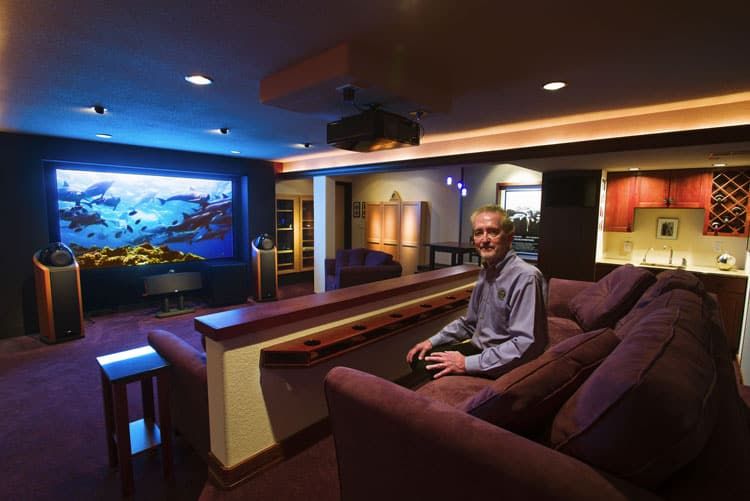“Better experience’ than the movies

Installing a home theater can offer a better visual and auditory experience than an outing to the movies, except there won’t be the concession stand popcorn.
“It all comes down to the basic desire to have video and audio reproduced as they are meant to be heard, as the director meant them to be,” said Trevor Fiorentino, owner of Harmonic Series Inc., a home audio store in Fort Collins. “If you want to make sure your movie theater is doing great, call Steven Spielberg … or you can call professionals like us, and we will make it happen.”
Home audio stores can sell and install the equipment — the projector, projection screen and speakers — but professional theater installers will be aware of the nuances of video and audio quality to better educate the buyer about the entire system, Fiorentino said.
SPONSORED CONTENT
“It comes down to video technology and what you’re actually getting out of the projector or TV and making sure that on the audio side, it makes you feel good,” Fiorentino said. “If it’s not calibrated right, over time you won’t enjoy the experience. It might be OK. You might never notice that it could be better, but you won’t get that feeling every time, that, oh my goodness, this is 100 times better than going to the theater to watch a movie.”
Home theaters have been popular for decades, but it was in 1982 that Dolby created surround sound for the home, amplifying the experience, Fiorentino said. Typically, home theaters, which can cost $15,000 to $100,000 or more to equip and install, are purchased by those who love movies and sports, want a concert experience, like to entertain and are into gaming, he said.
In Northern Colorado, home theaters most commonly are found in higher end homes, while media rooms are popular for a wide range of users, especially in an area favoring the outdoor lifestyle, Fiorentino said.
“They still want some place where they can hear good sound and watch a movie or watch TV and get something more than your typical TV watching experience,” Fiorentino said, adding that in Colorado, he sees more home theaters in large metro areas than in smaller cities and towns.
One in 100 homes in the area will have a home theater, said Jason Parmley, owner of Next Step Communications LLC, a home theater store in Mead.
Many of Parmley’s customers call him one to two years after they buy a new home, wanting to finish their basements, though some will build the theaters on the main floor, he said.
“People have home theaters to regroup to spend time with the family. … It’s a way for the family to slow down and be in one place,” Parmley said, adding that a theater room offers a distraction-free environment. “You’re there to enjoy a show.”
Home theaters are a dedicated room with a projector and projection screen that is fixed or motorized or a flat screen TV of 85 inches or larger and an audio system with surround sound, Fiorentino said. The audio system can be 5.1, 5.2, 7.1 and 7.2, referring to the number of speakers of five or seven and subwoofers of one or two, and at the high end, Dolby Atmost, he said. Dolby Atmost is the latest in surround sound technology that adds overhead speakers for spatial and object-oriented effects so that the sound seems to be located in space, he said.
For surround sound at the 5.1 or 5.2 levels, there are five speakers in addition to two in-ceiling or on-the-wall left and right speakers or channels. The speakers include left front, right front and center, plus surround left and surround right on the sides of the listening position. The 7.1 or 7.2 levels bring in two rear speakers behind the listening position.
To add to the sound quality, a theater room can be acoustically attuned, enabling the space to become ideal for presenting audio by getting rid of the echo and reverberation, said Robert Dreher, owner of Custom Quality Theaters, a home theater store in Boulder with a showroom in Longmont that designs, builds and installs the systems.
“A lot of people don’t realize the effects a room has on sound when they design and build a theater,” Dreher said. “It’s a difficult thing for people to get until they experience it, what that higher level provides.”
As for the video side of the experience, if projection screens are selected, the projection can be in front of or behind the screen, Dreher said. The screens are larger than the typical flat screen TV and provide a greater field of vision and pixel count for sharp, lifelike images called the window effect, he said. The pixel count can be 4K or 8K, referring to either 4,000 across and 2,000 down or 8,000 across and 4,000 down, he said.
“The whole color spectrum is amazing,” Dreher said. “With the image, the higher resolution and higher color range makes it so much more realistic. … The higher quality that it is, the more emotional the experience it is and it draws you in at a more emotional level.”
The color range, or enhanced color palette, comes from the high dynamic range, or HDR, Fiorentino said. A normal TV produces 16 million colors, while in the HDR realm, the range is a billion for a smoother transition in color instead of distinguishable bands of one color to the next, he said.
As an alternative to home theaters, media rooms are a flex space not dedicated to sound and video but to TV and entertaining, Fiorentino said. Instead of a projector, the rooms typically will have a large screen TV of 65 inches or higher with surround sound within the unit, he said.
Media rooms most often have couches, while home theaters can have luxury or custom seating, such as U-shaped couches with fabric matches or theater seating, though that is not as common, Fiorentino said.
“People are going more for a comfortable feel in their rooms,” Fiorentino said. “They don’t necessarily want it to be theater-like when it comes to comfort. They want it to be family room-like.”
Another trend for comfort is ceiling art, such as starry skies that make the ceiling look like a starry night with shooting stars or galaxies.
“It adds an element of luxury to your theater. It’s just cool,” Fiorentino said.
As for the walls, sound panels are popular to help dampen background noise and keep individual sounds well defined, instead of blurred together, Parmley said.
“It completely changes the whole feel of the room. When you walk in, everything gets quiet,” Parmley said.
Automatic lighting, another trend for home theaters, is controlled by a keypad to different themes, such as a movie setting with lights dimmed to 1 percent, Fiorentino said. Other settings can provide a glow behind the screen to better illuminate what is on the screen and theater lighting for experiential effects matched to the screen, he said.
“That’s where we’re at. If it’s done right, it’s a better experience than going to the movie theater,” Fiorentino said.
Installing a home theater can offer a better visual and auditory experience than an outing to the movies, except there won’t be the concession stand popcorn.
“It all comes down to the basic desire to have video and audio reproduced as they are meant to be heard, as the director meant them to be,” said Trevor Fiorentino, owner of Harmonic Series Inc., a home audio store in Fort Collins. “If you want to make sure your movie theater is doing great, call Steven Spielberg … or you can call professionals like us, and we will make…
THIS ARTICLE IS FOR SUBSCRIBERS ONLY
Continue reading for less than $3 per week!
Get a month of award-winning local business news, trends and insights
Access award-winning content today!




